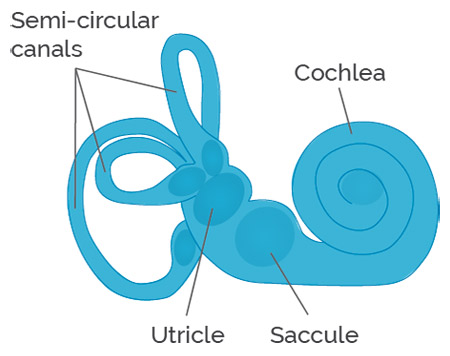Findings on Safe Vestibular Evoked Myogenic Potential Testing in Children
Tuesday, June 11, 2019
The vestibular evoked myogenic potential (VEMP) test is something you may encounter if you or a family member are experiencing issues with balance or dizziness. The VEMP is a non-invasive test that uses short, intense sound stimuli to produce a muscle reflex in the eye or neck muscles. The muscle reflex is recorded with surface electrodes that attach to the skin over the muscle. The test specifically informs clinicians about the health of vestibular components of the balance system—the utricle and saccule organs of the inner ear (Figure 1).

Figure 1. Diagram of the inner ear.
The inner ear in humans contains the auditory and balance systems. The utricle, saccule and semi-circular canals are central components of the balance system and process information about the head's position and movement in space. The cochlea is a central component of the auditory system.
In children, VEMP responses are correlated with development of standing, walking, and posture control [1, 2]. Children with impaired vestibular function are more likely to achieve these milestones at a later age [3], and can benefit from rehabilitation.
While the VEMP test is used with children, most of what we know about the test is from research and clinical experience with adults. It is not uncommon for doctors to need to rely information from adults for pediatric procedures but, because children are physically different, this can come with risks. For the VEMP test, there is some risk that the intensity of sound stimuli used for testing in adults is too loud in children and can damage the specialized cells in the ear that are crucial for hearing in children. It's also possible that children will respond better to different frequencies of sound than adults.
Understanding how the balance system works and develops is the focus of Kristen Janky, Ph.D, in her Vestibular and Balance Laboratory at Boys Town National Research Hospital. In a recent paper, Janky and Amanda Rodriguez explored optimum conditions for completing VEMP testing in children and young adults. They found that young children, ages 4–9, required significantly lower sound levels to elicit normal VEMP responses compared to adolescents or young adults. However, they found that there were no differences in response to the standard 500 Hz and 750 Hz frequencies that are used in testing [4].
TABLE 1. Mean (SD) VEMP thresholds at 500 Hz and 750 Hz for adults, adolescents, and children.
|
|
500 Hz | |
750 Hz | |
| | Mean
(dB SPL) | Standard Deviation
(dB SPL) | Mean
(dB SPL) | Standard Deviation
(dB SPL) |
Cervical VEMP Threshold
Response (dB SPL) |
|
|
|
|
| Adults |
111.5 |
3.25 |
112 |
2.61 |
| Adolescents | 107.5 | 4.85 | 109.5 | 3.68 |
| Children |
106 |
4.63 |
106 |
3.91 |
| Ocular VEMP Threshold Response (dB SPL) |
|
|
|
|
| Adults |
116 |
3.94 |
117 |
3.49 |
| Adolescents | 112.5 | 4.81 | 114.5 | 2.83 |
| Children |
111.1 |
4.10 |
112.2 |
4.17 |
Bold values represent significant differences. Children showed lower cervical and ocular VEMP thresholds compared to adults.
This research will help children by providing guidelines for safe VEMP testing in children, and keeping children's ears safe from possible injury. Experienced audiologists will already be careful with the ears of their young patients, but this knowledge will give them a better testing range, and information about what is normal responsiveness. For additional experiments, details and the authors' conclusions check out their paper,
Air-Conducted Vestibular Evoked Myogenic Potential Testing in Children, Adolescents, and Young Adults: Thresholds, Frequency Tuning, and Effects of Sound Exposure.
Thanks to the research volunteers for this study. Our volunteers included 10 children, ages 4–9, 10 adolescents, ages 10–19, and 10 young adults, ages 20–29.
References
- Wiener-Vacher, S.R., F. Toupet, and P. Narcy,
Canal and otolith vestibulo-ocular reflexes to vertical and off vertical axis rotations in children learning to walk. Acta Otolaryngol, 1996.
116(5): p. 657-65.
- Wang, S.J., W.S. Hsieh, and Y.H. Young,
Development of ocular vestibular-evoked myogenic potentials in small children. Laryngoscope, 2013.
123(2): p. 512-7.
- Inoue, A., et al.,
Effect of vestibular dysfunction on the development of gross motor function in children with profound hearing loss. Audiol Neurootol, 2013.
18(3): p. 143-51.
- Rodriguez, A.I., M.L.A. Thomas, and K.L. Janky,
Air-Conducted Vestibular Evoked Myogenic Potential Testing in Children, Adolescents, and Young Adults: Thresholds, Frequency Tuning, and Effects of Sound Exposure. Ear Hear, 2019.
40(1): p. 192-203.
